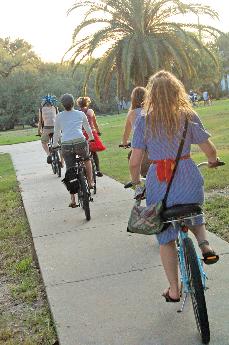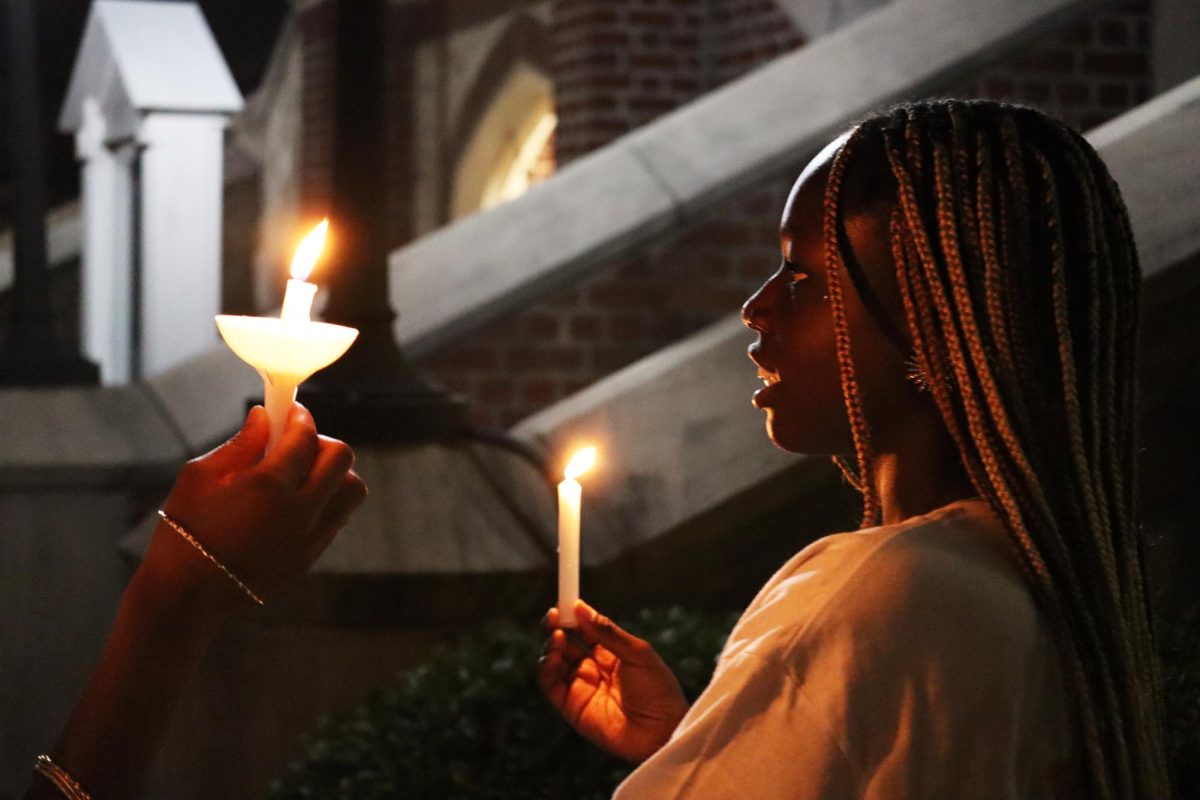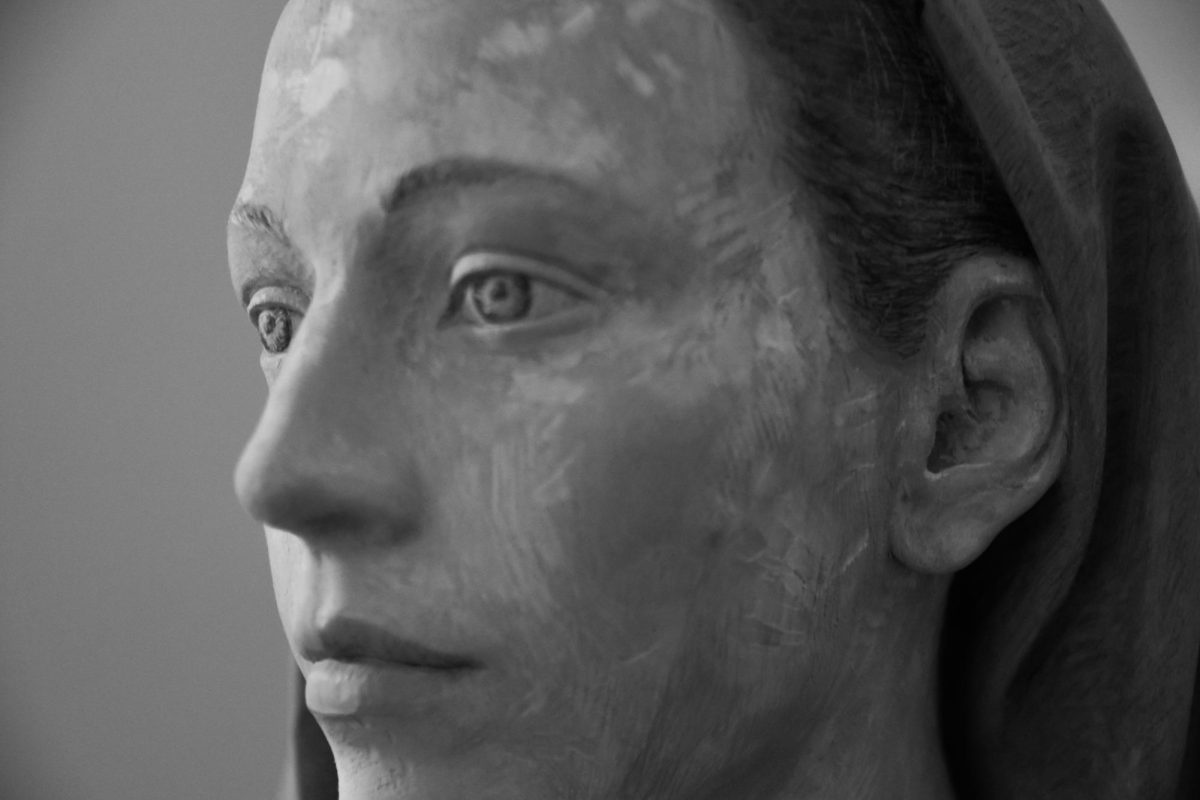Shirtless and wearing a jester’s hat, Kyle Throssell stood with his back facing visual arts junior Ingrid Anderson. He handed her three tubes of silver body paint, instructing her to write “Tired Mouse, Hungry Cat” on his bare back.
“Even if you’re tired of running, there’s still a hungry cat behind you,” said Throssell, an English writing junior, explaining the cryptic phrase.
Students arrived on bicycles, some costumed and some plain-clothed, gathered in Uptown’s Palmer Park for what would be their first Critical Mass ride. Throssell’s body art resonated as these cyclists began their inaugural venture down St. Charles Avenue: On a busy street among motorists, would they be the vulnerable rodents, or the predatory felines?
Critical Mass, originally called “Commute Clot,” is a movement that has its origins in San Francisco and has since diffused to other big cities like New York City and London. Cyclists – in the hundreds or in groups of less than 20 – take to the streets, usually once a month, to clog the arteries of cities as they ride alongside motorists during their daily commute.
Cyclists in groups of twos and threes started to become visible as they rode down South Carrollton Avenue toward the park. But with only about four cyclists joining Throssell, this Critical Mass ride wasn’t shaping up to be one of New York proportions.
That, however, didn’t deter Throssell.
“I don’t expect it to be like that,” he said of the big-city rides. “It would be fun, but things are different in the South. I anticipate we’ll have enough people to block off the road,” he said.
Regardless of the size or political leanings of the Critical Mass group, the common thread among these cyclists seemed to be the desire to disrupt rush-hour traffic. Some groups use a tactic called “corking,” where riders block traffic at intersections to allow cyclists to ride through red lights without interruption. This sometimes results in violent confrontations with drivers and police officers.
Reasons behind blocking traffic vary among the cyclists – some participate as a protest of carbon-producing cars, while others see it as a social activity. Many cyclists, including Throssell and the Loyola contigent, just want to prove that most city roads aren’t very friendly to cyclists and pedestrians.
Philosophy junior Chiara Marcial said she witnessed 200-plus people participate in a Critical Mass ride in Paris this summer, and explains how roads are much friendlier to cyclists there.
“Europe is built around pedestrians,” she said. “We need a lot more urban developments to provide for cyclists.”
Throssell also said his hometown of Albuquerque, N.M., is a lot more conducive to biking.
“You can bike absolutely anywhere. You can bike in bike lanes right along the freeway,” he said. “It’s hard to bike around here.” Throssell’s previous bike fell victim to the poor conditions of the city’s streets.
But even if they think that the roads are nicer to cars, there’s no hostility toward their motorist counterparts.
“I love cars. I love to drive them. But 90 percent of the time we use them, we could be on bikes,” Throssell says. “Cars are good – we just abuse them.”
Riders have different reasons for participating, but Critical Mass is largely leaderless and without a goal that defines the entire movement. Although Throssell has emerged as a leader of sorts, the group still embodies the non-hierarchical, informal style of Critical Mass.
“There’s no real purpose. People can do what they want. It’s all-inclusive. You don’t even make a choice-you’re already in,” he said. “It’s very Zen.”
But even tensions exist in the leaderless structure of Critical Mass. While these Loyola students prepared for their ride, the New Orleans Critical Mass group was in Jackson Square preparing for theirs.
“Yes, I’ve seen what the Loyola kids are trying to do,” Laura Harris, a Tulane student who participates in the monthly rides, said in an e-mail. “I think some of them didn’t realize a Critical Mass already existed in New Orleans and should join up with the main mass.”
Throssell knows about the New Orleans group, but he said that compromising on a location came with problems.
“We asked them if they wanted to meet up, but they didn’t seem too keen on the idea,” he said. “They were adamant about going downtown.”
Throssell prefers the Uptown location because of its proximity to students, and he believes that riding this route will make a bigger statement because it’s a “much bigger vein” for commuters.
But even if the two groups disagree on preferred routes, their goals are similar.
“It’s just to raise awareness. The more people on bikes, the less people in cars,” Harris said.
She echoed the same sentiments about tensions between motorists and cyclists.
“We share the road,” she said. “We have as much of a right to be on the road as cars do.”
Like with the New Orleans Critical Mass and groups in the rest of country, Throssell hopes to have monthly rides – but ideally, he would like the cyclists to hit the streets more frequently.
“Hopefully every day – every day, everyone on their bikes, riding,” he said. “It would be a glorious revolution.”
Six p.m. rolled around, the decided time for the ride, and the group totaled six cyclists. Throssell sent the group off with some final instructions: “You can bark at the drivers if you want.”
The cyclists took off – through the park, down South Carrolton and onto St. Charles avenues. This small group was just big enough to span the width of St. Charles. Traffic became noticeably slower on one side of the street as the cyclists rode ahead of the near bumper-to-bumper traffic. Drivers sat in their cars, visibly annoyed. They had accomplished their mission.
It was a Critical Mass group only six cyclists strong, but on that evening, these cyclists were the hungry cats.
Lauren LaBorde can be reached at [email protected].







